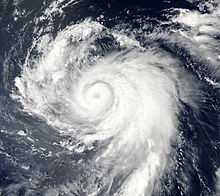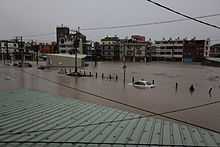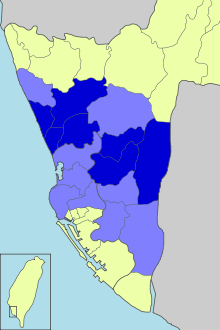Typhoon Fanapi
| Typhoon (JMA scale) | |
|---|---|
| Category 3 (Saffir–Simpson scale) | |
 Typhoon Fanapi approaching Taiwan on September 18 | |
| Formed | September 14, 2010 |
| Dissipated | September 21, 2010 |
| Highest winds |
10-minute sustained: 175 km/h (110 mph) 1-minute sustained: 195 km/h (120 mph) |
| Lowest pressure | 930 mbar (hPa); 27.46 inHg |
| Fatalities | 105 confirmed,[1] 42 missing |
| Damage | $986.7 million (2010 USD) |
| Areas affected | Taiwan, China |
| Part of the 2010 Pacific typhoon season | |
Typhoon Fanapi, known in the Philippines as Typhoon Inday, was the first typhoon to make landfall in Taiwan since Typhoon Morakot in August 2009. It was the eleventh tropical storm, seventh severe tropical storm and fourth typhoon in of the season. Fanapi, which means sandy islands, made its first landfall over Hualien, Taiwan early on September 19. After passing Taiwan, Fanapi weakened into a severe tropical storm and made its second landfall over Zhangpu in Fujian, China late on the same day. Fanapi caused severe floods in Kaohsiung, Taiwan and killed over 100 people in Guangdong, China. New and modified warnings were issued for the Taiwan coast on September 17, suspending all schools.[2] The Maokong Cable Car halted its operations.[3] As the typhoon closed in, President Ma Ying-jeou’s government mobilized more than 19,000 emergency workers. Electric lines were downed, schools, offices and transport was closed.[4] Three people died in Taiwan, on Saturday, in accidents related to the Typhoon.[5]
Tens of thousands of people were evacuated from many places across China and many business have also been closed on September 20 in preparation for the storm, as the Chinese government said that it could be the strongest storm to hit China in 2010.[6] The storm passed through the South China Sea, where much of China's offshore oil infrastructure is located. Crude imports in China were about to raise and the oil uture was in danger because of the shutdown of platforms.[7] As the storm closed into Hong Kong, meteorologists reported the system to landfall within 100 kilometers north of the territory overnight, bringing heavy rains and strong winds. They reported that the storm will sweep across Guangdong province causing severe floods and geological disasters to the region.[8]
The Kaohsiung Mass Rapid Transit system operated by the Kaohsiung Rapid Transit Corporation also suspended their service due to the damages possible by the typhoon.[9] 40 Schools around the country were damaged by the typhoon. Farm crops in Hualien city suffered a major damage. Estimated damage to the country was around US$3.87 million. Fearing residual effects, schools at many places remained closed on September 20.[10] More than one hundred buildings in Kaohsiung City sought spare water pumps to clean standing water in the basements because of the floods caused by the typhoon. For garbage cleaning and environment disinfection work, the Environmental Protection Bureau of KCG has dispatched 1,974 personnel and 458 vehicles.[11] On September 20, it was upgraded that more than 203 schools suffered damages in Taiwan. The damage to schools was US$1.78 million.[12]
According to the preliminary estimates, the total industrial damage was almost US$93.75 million by September 20. Almost 80% of Taiwan's companies remained closed on September 20.[13] Later on that day, the damage to schools was upgraded once again, saying that 438 schools suffered damages from the Typhoon. It was added that many schools will still remain closed on September 21.[14] It was said that the typhoon related flood victims were given US$945.92 per household. Houses affected by water at least 50 centimeters deep would be given US$630.61 as they said.[15] It was also reported that much of the damage was suffered in the agricultural field. Agricultural losses cause by Fanapi was more than US$65.27 million.[16] The residents of Taiwan finally started cleaning the surroundings of their homes which were badly flooded by the storm. As a finishing touch, the storm caused 1 direct death in Kaohsiung.[17] Despite the high damages to the country, the Kaohsiung chemical plants suffered a relatively low damage.[18]
The name Fanapi was retired at the 43rd annual meeting of ESCAP/WMO Typhoon Committee in Jeju in January 2011.[19] In February 2012, the committee selected the name Rai to replace Fanapi on the naming lists.[20]
Meteorological history

Late on September 14, 2010, the JMA reported that a tropical depression had formed southeast of Taiwan, and the JTWC soon designated it as 12W with the PAGASA naming it Inday shortly thereafter. Later that day, both the JMA and the JTWC upgraded the system to a tropical storm and named it Fanapi. On September 16, the storm intensified into a typhoon and turned northwest. On September 18, Fanapi further intensified to a category 3 typhoon and moved straight into Taiwan. It made landfall over Hualien County early on September 19.[21] Because of land interaction, Fanapi moved southwest, again turned west and weakened into a severe tropical storm. After staying inland for about nine hours, Fanapi moved to the Taiwan Strait and made its second landfall over Zhangpu in Fujian, China.[22][23] Late on September 20, Fanapi weakened into a tropical depression over Guangdong, China, and it dissipated completely on the next day. The Hong Kong Observatory issued the Number 1 Standby Warning after Fanapi made landfall in Taiwan. Two ays later during the evening it issued the Number 3 Strong Wind Warning because of increasing winds in the city. During the night, heavy winds and rain rocked the city, which had about 50 mm of rainfall an hour in the small hours of the morning. This prompted the HKO to issue the Red Rainstorm Warning. The next day, in the early morning at about 7:45, the observatory cancelled all the issued typhoon warnings.
Preparations and impact
Taiwan


Throughout south and east Taiwan, heavy rains triggered Landslides. Majia, Shangdewen and Weiliaoshan in mountainous parts of Pingtung County had received the highest amount of rainfall. The shipping route linking Xiamen, in east China's Fujian Province, and Jinmen, in Taiwan was closed as the typhoon closed in.[24] Taiwan High Speed Railway has also suspended a few trains during the landfall. Winds lashed through one of the windows of the Hualien Emergency Operation Center. Many trees in the Hualien city were also uprooted. 1,721 residents in Hualien were evacuated. 314,000 households in the island were without power. Many reservoirs were filled to capacity. The Shihmen Reservoir in Taoyuan County (now Taoyuan City), the Mingde Reservoir in Miaoli County, and the Baihe Reservoir in Tainan County (now part of Tainan City) had to open their floodgates.[25] The inaugural Yeangder Tournament Players Championship was reduced to a 54-stroke play due to the Typhoon.[26] With a fear that the typhoon would destroy the crops, farmers hurriedly harvested all their crops and sold them in a wholesale. This caused the fruits and vegetable prices to run down by 15% on September 19. 2,155 tons of vegetables were sold at Tapei City Fruit and Vegetable Wholesale Market on that day. However, the prices of some premium vegetables remained stable.[27] Landslide warnings were issued against 61 rivers in Taiwan. The typhoon also caused 14 breakages on the highways.[28] Seeing the admages caused in Taiwan, the China Meteorological Administration raised the level of alert for Typhoon Fanapi. It was reported that Fanapi will subside somewhat shortly after making landfall and heavy rains are unlikely.[29] According to the Central Emergency Operation, two Kaohsiung residents went missing and 75 were injured nationwide. 70 people living in Hualien were injured out of all the 75 in the ntion. Most of them fell over while driving. Downtown Kaohsiung, including Sanmin, Nanzih, Zuoying and Gushan districts were affected by floods.
_approaching_China.jpg)

The typhoon smashed through banana, tea, corn, rice and pineapple cropsover 2,046 hectares of farmland. The residents of Kaohsiung blamed the city's sewage system for the floods. They claimed that the sewers were not designed to withstand the rainwater pored by Fanapi. Mayor Chen Chu said that the natural disaster fund will be activated if worse comes to worst.[31] Kaohsiung city Animal shelters were also damaged in the wake of the typhoon.[32] Almost nine in all eleven administrative districts in Kaohsiung City were filled with water.[33] The Environmental Protection Administration, the Department of Health and the Ministry of National Defense were asked to help with the situations in Taiwan on Monday. Thousands of residents in Kaohsiung County (now part of Kaohsiung City), Nantou County, Chiayi County, Taitung County, Hualien County and Pingtung County were evacuated to temporary shelters supervised by the military by Monday. Taiwan's flood control facilities were also challenged by Wu Den-yih.[34] On September 21, it was reported that the compensation to a family would be increased to US$1261.22.[35] On that day, another person was found dead, increasing the direct death toll to two.[36] The total damage was totaled to US$210.9 million by the Government of Taiwan.[37]
China
In addition to the heavy torrential rain, the storm delivered strong gusts to China after sweeping through Taiwan in nine hours. It was reported that this storm brought the heaviest rains in a century to the southern Guangdong Province, triggering landslides in some cities. The storm caused destruction in Fujian and Guangdong before weakening into a low pressure area. Shuangyao Township in Yangchun City was the worst hit by the storm when precipitation totaled 550 mm in 24 hours. Floods and landslides were triggered in Maoming City where more than 8,000 people were evacuated but no deaths were reported. Gaozhou and Xinyi were also badly hit. Rain still battered parts of Guangdong for the rest of the day. Six counties in Fujian Province experienced more than 200 mm of rain in 23 hours.[38] By September 22, the storm had killed 13 people and left dozens missing.[39] The death toll rose to 54 with another 42 people still missing according to a spokesman on September 23. On September 24, the death toll reached to 70 reported by state-run Xinhua News Agency citing relief officials. Although the momentum of the typhoon decreased after pummeling the southern part of Taiwan, the hurricane still caused direct economic losses of $315 million and the destruction of 3,647 homes, with 35,900 hectares of cropland inundated.[40]
See also
References
- ↑ "Fanapi death toll hits 100". The Straits Times. September 28, 2010. Retrieved 28 September 2010.
- ↑ "Taiwan, China on alert as powerful typhoon nears". The Inquirer. 18 September 2010. Retrieved 23 September 2010.
- ↑ "Taiwan braces for typhoon Fanapi". Xinhua. 18 September 2010. Retrieved 23 September 2010.
- ↑ "Typhoon Fanapi Cuts Power, Closes Airports, Forces Evacuations in". NowPublic. 19 September 2010. Retrieved 23 September 2010.
- ↑ "Cna English News". Focustaiwan.tw. 2010-09-18. Retrieved 2010-09-24.
- ↑ "Typhoon Fanapi Hits China | Asia | English". Voanews.com. 2010-09-20. Retrieved 2010-09-24.
- ↑ "OIL FUTURES: Crude Up on Technical Rebound, Storm Concerns - WSJ.com". Online.wsj.com. 2010-09-20. Retrieved 2010-09-24.
- ↑ "AFP: Taiwan clear up begins after typhoon flooding". Google.com. 2010-09-19. Retrieved 2010-09-24.
- ↑ "Typhoon Fanapi causes two missing in Kaohsiung and 75 injured nationwide - Taiwan News Online". Etaiwannews.com. 2010-09-19. Retrieved 2010-09-24.
- ↑ "Cna English News". Focustaiwan.tw. 2010-09-19. Retrieved 2010-09-24.
- ↑ "Kaohsiung City seeks aids in cleaning standing water - Taiwan News Online". Etaiwannews.com. 2010-09-20. Retrieved 2010-09-24.
- ↑ "Reports flood in of schools damaged by Typhoon Fanapi: MOE - CNA ENGLISH NEWS". Focustaiwan.tw. 2010-09-20. Retrieved 2010-09-24.
- ↑ "Typhoon-related industrial losses estimated at NT$3 billion: MOEA - CNA ENGLISH NEWS". Focustaiwan.tw. 2010-09-20. Retrieved 2010-09-24.
- ↑ "Cna English News". Focustaiwan.tw. 2010-09-20. Retrieved 2010-09-24.
- ↑ "Cna English News". Focustaiwan.tw. 2010-09-20. Retrieved 2010-09-24.
- ↑ "Cna English News". Focustaiwan.tw. 2010-09-20. Retrieved 2010-09-24.
- ↑ "Typhoon Fanapi causes one death in Kaohsiung - CNA ENGLISH NEWS". Focustaiwan.tw. 2010-09-20. Retrieved 2010-09-24.
- ↑ "Flood damage to Kaohsiung chemical plants less than expected - CNA ENGLISH NEWS". Focustaiwan.tw. 2010-09-20. Retrieved 2010-09-24.
- ↑ "Forty-Third Session of Typhoon Committee" (PDF). Typhoon Committee. January 2011. Retrieved 2012-02-28.
- ↑ "Forty-Fourth Session of Typhoon Committee" (PDF). Typhoon Committee. February 2012. Retrieved 2012-02-28.
- ↑ Typhoon Fanapi lashes Taiwan | Herald Sun
- ↑ BERNAMA - Typhoon Fanapi Lands On Fujian Province
- ↑ Typhoon Fanapi hits Chinese coast - MarketWatch
- ↑ "Taiwan Strait shipping route closed as Typhoon Fanapi nears". News.xinhuanet.com. 2010-09-19. Retrieved 2010-09-24.
- ↑ "Typhoon Fanapi moves away from Taiwan - CNA ENGLISH NEWS". Focustaiwan.tw. 2010-09-19. Retrieved 2010-09-24.
- ↑ "The Press Association: Typhoon hands Thaworn win". Google.com. Retrieved 2010-09-24.
- ↑ "Typhoon Fanapi's arrival sends vegetable prices lower - CNA ENGLISH NEWS". Focustaiwan.tw. 2010-09-19. Retrieved 2010-09-24.
- ↑ "Council of Agriculture issues landslide warning against 61 rivers in Taiwan - Taiwan News Online". Etaiwannews.com. 2010-09-19. Retrieved 2010-09-24.
- ↑ "China upgrades warning level for strong Typhoon Fanapi". News.xinhuanet.com. 2010-09-19. Retrieved 2010-09-24.
- ↑ "高縣市成澤國 水淹一樓高". Apple Daily. 2010-09-20. Retrieved 2010-09-20.
- ↑ "Typhoon Fanapi inflicts heavy damage on Taiwan - CNA ENGLISH NEWS". Focustaiwan.tw. 2010-09-20. Retrieved 2010-09-24.
- ↑ "Animal shelters damaged by typhoon - CNA ENGLISH NEWS". Focustaiwan.tw. 2010-09-20. Retrieved 2010-09-24.
- ↑ "Kaohsiung City Government investigates into causes as floods recede - Taiwan News Online". Etaiwannews.com. 2010-09-20. Retrieved 2010-09-24.
- ↑ "Cna English News". Focustaiwan.tw. 2010-09-20. Retrieved 2010-09-24.
- ↑ "archives". Taipei Times. Retrieved 2010-09-24.
- ↑ DEBBY WU (2010-09-20). "The Associated Press: Taiwan cleans up after powerful typhoon; 2 dead". Google.com. Retrieved 2010-09-24.
- ↑ "Taiwan typhoon kills 2". Straitstimes.com. Retrieved 2010-09-24.
- ↑
- ↑ "13 killed, 33 missing in China after typhoon Fanapi". Hindustan Times. Retrieved 2010-09-24.
- ↑ "Typhoon Fanapi kills 54 in South China". Chinadaily.com.cn. 2010-09-21. Retrieved 2010-09-25.
External links
| Wikimedia Commons has media related to Typhoon Fanapi. |
- JMA General Information of Typhoon Fanapi (1011) from Digital Typhoon
- RSMC Tokyo - Typhoon Center
- Best Track Data of Typhoon Fanapi (1011) (Japanese)
- Best Track Data (Graphics) of Typhoon Fanapi (1011)
- Best Track Data (Text)
- JTWC Best Track Data of Typhoon 12W (Fanapi)
- 12W.FANAPI from the U.S. Naval Research Laboratory
| ||||||||||||||
| ||||||||||||||||||||||||||||||||||||||||||||||||||||||||||||||||||||||||||||||||||||||||||||||||||||||||||